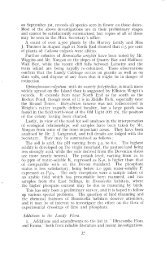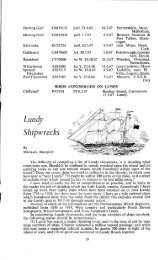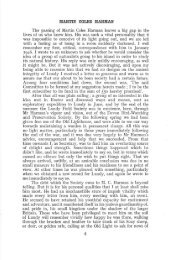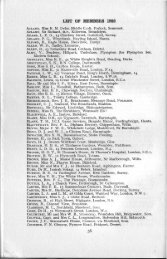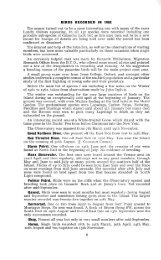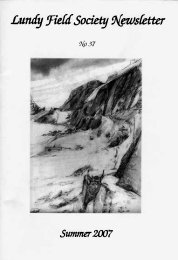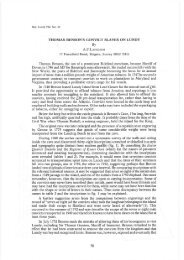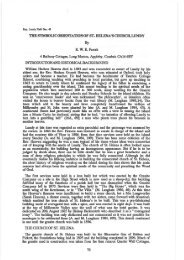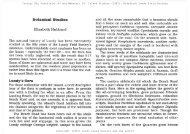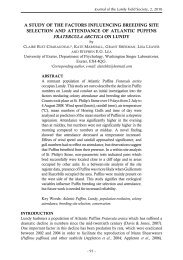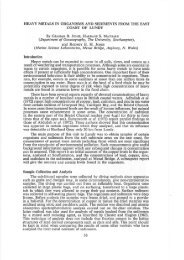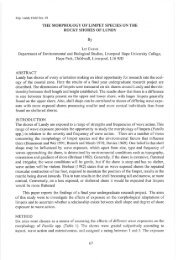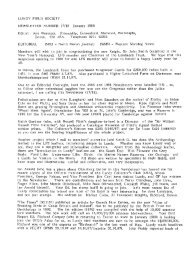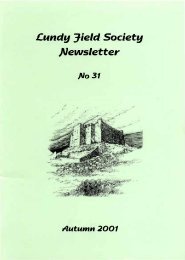THE LICHEN FLORA OF LUNDY: II THE COMMUNITIES By PETER ...
THE LICHEN FLORA OF LUNDY: II THE COMMUNITIES By PETER ...
THE LICHEN FLORA OF LUNDY: II THE COMMUNITIES By PETER ...
Create successful ePaper yourself
Turn your PDF publications into a flip-book with our unique Google optimized e-Paper software.
for fieldwork. Aspect, vertical heights and general features of individual substrates werenoted when applicable. Zonation and distribution of supralittoral lichens on siliceousrocky shores follow those described by Fletcher 1973a, 1973b and 1975. Shoreexposures were estimated using key seaweed indicators as given in the Ballantine scale(Ballantine 1961 ). This scale of shore exposure is from Grade I (extremely exposed ason island headlands) to Grade 8 (extremely sheltered as in a sea loch). Most speciesdeterminations were made in the field ·aided by standard chemical tests, but criticalmaterial was carefully examined in the laboratory and, where necessary, subjected tothin layer chromatography (White and James 1987). Abundance and percentage coverwere estimated using a subjective intuitive methodology referring to a five-point scaleof frequency within a sampling area of approximately I m2 Reference should be madeto the species list of Lundy lichens for details of frequency, substrate preference andhabitat (See James eta/. 1996).Findings on Lundy lichen communities are arranged as follows:SILICEOUS ROCK <strong>COMMUNITIES</strong>A Marine (Littoral) Fringe and Maritime CommunitiesB Inland CommunitiesC Slate Rock CommunitiesSUCCESSION SEQUENCE ON GRANITE DOMES AND PEATCALCICOLOUS <strong>COMMUNITIES</strong>BEACON HILL CEMETERYTERRICOLOUS <strong>COMMUNITIES</strong>: Rhododendron PathEPHYPHYTIC <strong>COMMUNITIES</strong>: TREESA The Epiphytic Lichens, Trees and Summary Table8 Factors Affecting the Distribution of Epiphytic LichensSILICEOUS ROCK <strong>COMMUNITIES</strong>The lichen communities on the siliceous rocks of Lundy are described following theestablished nomenclature cited in James et a/, 1977. Distinctive, often easilyrecognisable, assemblages are referred to as Associations; interrelated Associations aremembers of larger groupings called Alliances. The lichen Associations should not beconsidered as discrete assemblages but as a series of intergrading communities (noda)with (usually) constant key specie~ and at least a few species in common with adjacentAssociations.A Marine (littoral) Fringe and Maritime (supralittoral) CommunitiesLichens in marine and maritime communities are mostly salt dependent and aretherefore mainly exclusive to these communities. Their zonation reflects complexrelationships between climatic, physical and chemical variables. The most important ofthese are: salt gradient, exposure, aspect (light, temperature, desiccation), rock type andits nutrient status, pH, tolerance to fluctuations in freshwater, texture of rock, andnutrient-enrichment from external sources, eg seabird excreta. The following communities,from seashore landward, are described:*****Verrucarietum maurae Association: upper littoral or littoral ftinge hlack zoneCaloplacetum marinae Association: mesic lower supralittoral orange zoneXanthorion parietinae Alliance: submesic supralittoral yellow zone. (This zone,which indicates more extreme nutrient enrichment, is not always welldeveloped; when present it infiltrates the upper mesic and/or lower xericzones.)Ramalinetum scopularis Association: xeric upper supralittoral grey zoneSclerophytetum circumscriptae Association: dry sheltered recesses within theRamalinetum scopularis94
The lichens of the more sheltered and shaded aspects within this association are verydiverse; low down on the bluffs of the western side and also at the northeast of theisland there are extensive patches of Rinodina beccariana (= R. subglaucescens), withDiploicia canescens and the easily overlooked, often sterile, Lecanora tenera. A driercomponent of this community, the Sclerophytetum circumscriptae Association (James1970), which is surprisingly poorly developed on the island, is present on the north sideof Tibbett's Point and includes Chiodecton myrtico/a (sterile), Dirina massiliensis f.sorediata and Sc/erophyton circumscriptum; occasionally, Rocce/la phycopsis in smallsheltered crevices enters this association on the west side of the island.A distinctive and specialised terricolous/corticolous/lignicolous lichen communityassociated with dead Armeria tussocks occurs within the Ramalinetum scopularisAssociation. This was examined at the Northwest Point (Virgin's Spring region) andabove Northeast Point where the east-facing slope near the bridge to the NorthLighthouse supports a rich growth of Armeria. Especially common on these mounds are:Anaptychia runcinata, C/adonia cervicornis, C. ramulosa, with smaller amounts ofLecanora expa/lens, Lepraria incana, Micaria prasina, Ochro/echia androgyna,Parmelia su/cata and Rinodina roboris (rare); Ramalina siliquosa and R. subfarinaceaare widely dispersed throughout. C/adonia species locally abundant on the numerousdead tufts include C. ch/orophaea, C. furcata, C. foliacea and C. polydactyla; C..floerkeana and C. rangiformis are rare.Selected shoresa) Landing BeachThis site, a laminated slate shore (exposure Grade 6), is sheltered from the prevailingsouth-west wind and shaded much of the time being north- and east-facing and is moremoisture retentive than equivalent granite shores. The fragile, crumbling slate rock,which is constantly naturally eroding, comes under further stress from pedestrian andvehicular traffic. Overall, the two communities (in the black and orange zones) are verynarrow (each only about lm in vertical height), although with the impact of increasingsalt spray they tend to extend landwards onto the more open vertical sea-facing rockshigher up the coast road where the hewn rocks of the roadside walls are particularlyinteresting. Verrucaria maura forms a distinct zone, extending upwards in damp cracksand runnels. Nowhere here is Ca/oplaca marina well developed due to its intolerance ofthe more shaded, moisture-retaining conditions. Other species in this community includeCaloplaca microtha/lina, C. thallincola (not common), Catil/aria chalybeia,Dip/otomma alboatrum, D. ch/orophaeum, Lecania atrynoides, L. erysibe, L. turicensis,Lecanora actophi/a, L. cenisia var. atrynea, L. dispersa, L. helicopis, Lichina confinis,Ochrolechia parella, Opegrapha conferta, Rama/ina siliquosa, Tephrome/a atra (somelarge colonies), Toninia aromatica, Verrucaria prominula and Xanthoria parietina.Apart from Opegrapha conferta, common on the moist surfaces and ends of brokenbedded slate, none of these species· is particularly frequent. Some are more characteristicof the Ramalinetum scopularis Association above and are thinly distributed in thisfrequently disturbed, compacted and rather poorly colonised orange zone.b) Brazen Ward (See Fig. l)This very interesting site is dominated by an east-facing, granite tongue projectinglaterally into the sea with a very sheltered, steep, north-facing side protected by the bay,the whole shore being moderately to very sheltered (exposure Grade 6). The tip (b) andsouth side of the tongue are more open and exposed, with the sloping, shelved southside receiving sun on its south- and west-facing vertical surfaces. Moreover the tongueitself has a central dome (d) which is more elevated than the surrounding rock. Thisdome and the long horizontal extension give an erroneous impression of a large· area ofblack and orange zones, but these are merely stretched outwards, and collectively invertical height do not reach more than 3m in any one place on the tongue. However,this large horizontal extension out to sea provides much surface for the development ofa flourishing maritime community subject to salt spray from various directions andconsiderable nutrient enrichment from bird droppings.96
aytip: Caloplacetummarinae (b)shadedwall withOoegraphetum/, • ' littoral barnacles and seaweeds~--·-- :;::::::::. Verrucarietum maurae (a)~ Caloplacetum marinae (c)BUU.DINGREMAINSDO......... :~pathsheltered platform (e)Xanthorion oarietinaeLecania aipospilaOLD WALLSection through dome of 'tongue'sXanthoria parielina dominant (d)(Xanthorion parietinae)BUU.DINGREMAINSlandwardsideVerrucarietummauraeCaloplaca marinaco-Jominant withLecanora helicopis (b)(Caloplacetum marinae)Caloplaca marinadominant (c)(Caloplacetum marinae)Figure I: Brazen Ward: Zonation of Supralittoral Lichen Communities97
The Verrucarietum maurae Association, which extends vertically from the sea for upto 2m, is also well developed around the tongue, especially on the south side wherewaves lap and splash higher on the more sloping lower rock platform (a). (Verrucariahalizoa, V. mucosa, V. striatula and Pyrenocollema elegans are generally lower down inthe littoral zone and are associated with the seaweeds Pelvetia canaliculata andCatanella sp. coinciding with the upper limits of barnacle colonisation). Verrucariamaura continues to fill declivities and cracks in horizontal rock up through the mesic(orange) zone (pH of crevice soil 6.5) and into the grey zone above (pH of crevice soilbelow 4.5). The surface of the tip of the tongue (b) has a Caloplacetum marinaeAssociation with C. marina co-dominant with Lecanora helicopis on the flat tops, V.maura in the crevices, and some Caloplaca verrucul!fera, Lecania aipospila andXanthoria parietina on the damper sides of the blocks of rock where surface moisture isretained longer and nutrient-emichment more concentrated.On the landward side of the dome there is a second well developed orangeCaloplacetum marinae Association (c) with C. marina on the sunnier edges of thestepped south-west-facing rock and vettical sides of west-facing blocks. Included in thisdiverse community are: Diploicia canescens, Diplotomma alboatrum, Halecania ralfSii,Lecanora gangaleoides, L. helicopis, Lecidella asema, L. scabra, Lichina confinis(little), Ochrolechia parella, Parmelia delisei, P. pulla, Physcia adscendens, Ramalinacuspidata, Rinodina gennarii, Xanthoria parietina, with Lecania aipospila in the dampgullies. Aspicilia leprosescens and Tephromela atra (sparse) occur on the tops of theridges receiving extra nutrient enrichment. Lecanora he/icopis is an important memberof the Caloplacetum marinae Association here, but is not as abundant as at the tip of thetongue (b). Lecanora actophila is scarce, restricted to a few better lit, south-facingvertical-sided boulders. On sunny outcrops, Caloplaca marina is scattered even further,among members of the higher Ramalinetum scopularis Association, these latter oftenshowing a preference for at least some nutrient enrichment.Some of the species of the Caloplacetum marinae are also found more landward wherea damp, sheltered horizontal platform (e) (pH of crevice soil 6.0) supports an almostcomplete coverage of Lecania aipospila with Aspicilia leprosescens, Lecanorapo/iophaea (rare) and Verrucaria prominula. In the most sheltered aspects Solenopsoravulturiensis, Micarea prasina and Lecania baeomma occur on friab le rock or soil, all ofwhich are indicator species of low level nutrient enrichment from nearby seepage tracks.The upper part of the dome (d), rising up to 2m above these two Caloplacacommunities, is one of the most distinctive features at Brazen Ward. It represents aXanthorion parietinae Alliance but supports a very unusual community, dominatedoverall by Lecania aipospi/a and Xanthoria parietina with scattered islets of Verrucariamaura chiefly confined to cracks .. Extensive patches of Lecania aipospila haveCaloplaca verrucul!fera at their margins interspersed with tiny islands of Phaeophysciaorbicularis and some colonies (often in tiny depressions) of Rinodina orculariopsis.These are the key species of this interesting community which is influenced by acombination of factors including aspect, marked increase in nutrient status due to birddroppings, freq uent salt spray and in wet weather petiodic soaking with freshwater fromrain. L. aipospila further extends down the landward slope from the dome where it isassociated with scattered Rama/ina siliquosa rather than X parietina.c) North Lighthouse Quay (See Fig. 2)This near-vertical and exposed supralittoral site (exposure Grade 2-3), accessible by aseries of steps to the quay, is mostly north-facing with rock outcrops and boulderssubjected to some nutrient enrichment where some outcrops are bird perching rocks(Fig. 2). The Verrucaria and Caloplaca zones and transitional Xanthoria-domiilatedzone are all extended upwards to a vettical height of about 30m under the influence ofwave and spray effects. While granite predominates, there is also a narrow, softer dykeof trachyte (more water-retentive and of different, more basic mineral composition)which, due to erosion, often lies in depressions and therefore is often more .shaded andsheltered. The pH of the crevice soil is approximately 6.0 throughout the 30m, but onceclearly in the Ramalinetum scopularis Association, as at the bridge at about50 m, the pHvalue fa lls below 4.5.98
IRamalinasi/iquosa(dry verticalrock) 1<strong>II</strong><strong>II</strong><strong>II</strong><strong>II</strong><strong>II</strong><strong>II</strong>o/MHWSupralittoralHeight in metresabove MHW"' if'I :I <strong>II</strong> <strong>II</strong> <strong>II</strong>Xanthoria 1 Iparietina : I(bird perches, 1i"'T'' l !T ..L <strong>II</strong> T <strong>II</strong> Caloplaca 1J manna11 (sunny dry 1~ rock) l !-r .LVerr!M.1maura(damp crevices)3530252015105Ramalinetum scopularisOchro/echia parella now commonOpegraphetumhoristico-gyrocaroae (see p.IOI)(moist shade, sheltered recesses)Calop/aca /ittorea (dry shade)Calop/aca britannica(moist shelter)Verrucaria prominulaGrimmia maritima (moss)ArmeriamaritimaXanthorion parietinaedamp trachv1e dyke 1Solenopsora vulturiensis,IToninia aromatica, T. mesoidea 1Ca/op/aca microthal/ina, C. thallincolaCaloplacetum marinaeLecanora po/iophaea, Lecania aipospi/a(damp, nutrient-enriched)Ii1..vCaloplaca verrucu/ifera (nutrient-enriched)Calop/aca thallincolaLecanora actophila (rare), L. helicopis (common)Calop/aca microthallinaLichina confinisVerrucarietum maurae~Q~U~A~Y--------~~0~------------------------------Pyrenoco//ema elegans, P. orustense (N-facing wall)Verrucaria halizoa, V striatulaPyrenocollema halodytes, P. sub/itorale(on barnacles)Figure 2: North Lighthouse Quay: Lichen Zonation, North-facing, +/- Vertical Rock99
The Verrucarietum maurae is welt develope'd for approximately 8m and extendsupwards locally in crevices and sheltered aspects for many metres further. V mauraalmost entirely covers the vertical faces of the rock at this level but is, here and there,mixed with small amounts of Caloplaca marina, C microthallina, Lecanora helicopisand Lichina confinis on horizontal rock surfaces. Just below in the barnacle zone (upperlittoral) are Pyrenocollema halodytes and P. sublittorale on barnacles, P. e/egans and P.orustense on a north-facing walt of the landing stage and Verrucaria ha/izoa and Vstriatula on adjacent rock surfaces. Near the upper limit of the Verrucaria maura zone,in shelter and shade, are very small amounts of Caloplaca thallinco/a, C verruculifera,Lecanora poliophaea and Xanthoria parietina, the last three species indicatingenhanced nutrient enrichment.The Caloplacetum marinae mesic community extends for a further 8m, but Caloplacamarina is chiefly confined to drier, sunnier, well-drained extremities of rock exposures.Lecania aipospila and Lecanora po/iophaea are indicator species of the dampernutrient-enriched surfaces. Not unexpectedly on a north-facing site Lecanora actophilais rare.The Xanthorion parietinae, influenced by sea bird perches, extends upwards a further18m with Caloplaca marina and Verrucaria maura still present in the community inappropriate places. Armeria maritima is anchored in crevices and becoming weltestablished at this level. This represents the lower edge of the grey Ramalinetumscopularis Association, with Ramalina siliquosa restricted to drier vertical surfaces.There are several significant microhabitats, including the trachyte dyke intrusion andmortar and cement, of and alongside the often damp steps. Ca/oplaca microthallina andXanthoria parietina are particularly welt developed on the dyke substrate, even at thiselevation, and C thallinco/a, with Solenopsora vulturiensis, Toninia aromatica and T.meso idea, also occur on the dyke at 22m.Where the tussocks of Armeria maritima are common at 25m, the soil componentincreases considerably between outcrops. Significant in this community, the lowermostRamalinetum scopularis, is Caloplaca britannica on sheltered rock beneath the paintedmetal handrail. The isidiate C littorea becomes widespread in sheltered dry underhangs,while in somewhat moister underhangs a shade community corresponding to theOpegraphetum horistico-gyrocarpae Association is present which includes Bacidiascopulico!a, Buel/ia puncta/a, Caloplaca littorea, C verruculifera, Lecanora tenera,Opegrapha cesareensis, Ramalina canariensis, Sco/iciosporum umbrinum and Toninamesoidea. This community at 35m above sea level closely resembles the very weltdeveloped examples at The Battery at a similar height and at Brazen Ward only about3m above mean high water (MHW). This confirms the importance of exposure invertically extending the lichens in the supralittoral zone (See Allen and Hilton 1987).d) The BatteryAccess to the lowest west-facing granite rocks at The Battery is difficult. However, atabout 35m above the sea the presence of a Caloplaca mesic community on awest-facing granite wall by the main buildings again shows the role of the degree ofexposure in elevating and widening this zone. Here at The Battery the rock is muchsunnier, warmer and drier than at the North Lighthouse Quay and there is an abundanceof Lecanora actophila with frequent Caloplaca marina and Lecanora helicopis withsome Anaptychia runcinata; Verrucaria maura is in the damp cracks. The pH of soil inthis wall is alkaline (pH 7.2) which illustrates the influence of the salt spray associatedwith the development of the mesic supralittoral community, the Caloplacetum marinaeAssociation.The Batte1y ruins and immediate surroundings are rich in lichens and provide acomplexity within which several communities converge and overlap. These associationsare discussed elsewhere in this paper, but special mention must be made of theinteresting example of the Opegraphetum horistico-gyrocarpae Association found on alow, ve1y sheltered, damp, hewn, north-facing vertical granite rock face in a narrowalley at the side of the buildings, as well as the occurrence there of two uncommonspecies of Ramalina, R. lacera and R. portuensis.100
8 Inland CommunitiesOn the more exposed western side of the island the Ramalinetum scopularis penetratesinland much further than on the eastern side (more sheltered from prevailing winds)where it is more narrow, closer to the shoreline and less well-defined. While there is amaritime influence (salt-laden winds) generally over all of Lundy extending thedistribution of many salt-tolerant (halophilic) species, areas of shelter, especially on theeastern side, contribute to the infiltration of a number of salt-intolerant (halophobic)species. This leads to the occurrence of communities which, apart from the inclusion ofsome halophilic species, might be found elsewhere in Britain, albeit often adjacent tocoastal areas of southwest England.Shade associations* Lecideetum orostheae Association* Opegraphetum horistico-gyrocarpae AssociationParmelion conspersae Alliance (Nutrient-enrichment)* Candelarielletum corallizae Association* Parrnelietum glomelliferae AssociationParmelion perlatae Alliance* Parrnelietum revolutae Association* Teloschistetum flavicantis AssociationExposed association* Parrnelietum omphalodis Associati~nShade associationsLecideetum orostheae AssociationDry, but relatively well-lit, recesses support extensive patches of Haematommaochroleucum var. porphyrium (sometimes fertile) with Lecanora gangaleoides (often inan emaciated, ecologically stressed, condition), L. orosthea, Lepraria incana,Leproloma membranceum and Psilolechia Iucida; their assemblage corresponds to theLecideetum orostheae Association, and also includes on Lundy the very rare Ramalinapollinaria, probably more frequent here than at any of its few other stations in Britain.Opegraphetum horistico-gymcm:pae AssociationIn sheltered, more moisture-retentive recesses, elements of the association Opegraphetumhoristico-gyrocarpae Association are found, including Bacidia scopulicola,Catillaria chalybeia, Lecania baeomma, Lepraria incana, Leprocaulon microscopicum,Opegrapha caesareensis, 0. conferta, 0. multipuncta, Scoliciosporum umbrinum,Solenopsora vulturiensis and Verrucaria maura. However, the key species Enterographazonata and Opegrapha gyrocarpa, are very rare on the island. The Lundyrepresentatives of the Association are found at North West Point, Brazen Ward and areparticularly well developed on a shaded rock cutting by the ruins at The Battery. Afragmentary example of this Association, containing Enterographa zonata withLecanora tenera (as fertile and sorediate ecotypes), Haematomma ochroleucum var.porphyrium, Lecania baeomma and Porpidia platycarpoides, occurs on a sheltered,rather damp, north-facing wall in Quarry C. The only other recorded occurrence ofEnterographa zonata is on the south-east-facing shaded slate wall of the calor gasstorehouse by the harbour roadside (near Millcombe House) where it occurs withOpegrapha gyrocarpa and includes the following additional species: Caloplaca citrina,Diplotomma alboatrum, D. chlorophaeum, Dirina massiliensis f. sorediata, Lecanoragangaleoides, Lepraria incana, Leproloma membranaceum , Ochrolechia parella,Opegrapha conferta, 0. saxatilis, Polysporina simplex, Porina chlorotica, Rhizocarponconcentricum and R. obscuratum.Parmelion conspersae AllianceThe Parrnelion conspersae Alliance comprises assoctatwns on well-illuminated,slightly to markedly nutrient-enriched siliceous rocks. It is well represented and diverseover much of the plateau granite outcrops, especially those north of Quarter Wall and101
intergrades at the cliff edges, often imperceptibly, into the Ramalinetum scopularisAssociation. The two major associations of this Alliance relevant to Lundy are thenutrient-rich Candelarielletum corallizae, which is local, and the Parmelietumglomelliferae, which is predominant on rocks over most of the central area of the island.A further Association, the Lecanoretum sordidae, predominantly of crustose species, isweakly represented on more nutrient-enriched slate rock, but is here, however,insufficiently distinct from the Parmelietum glomelliferae to warrant separate status.Candelarielletum corallizae AssociationThe Candelarielletum corallizae Association is characteristic of nutrient-enriched sites,especially bird-perching rocks. Away from the coast such sites are relatively limited onLundy and this special community is probably best observed on the granite markerstones at the sides of the main track to the North End and, more rarely,nutrient-enriched stones on walls. The marker stones average approximately m in heightand their summits are frequently used as territorial markers by birds. The compositionof the lichen flora on these stones does not indicate such extreme eutrophication asoccurs on similar sites on Skomer (Wolseley et a/. 1996), but nevertheless a proportionof them support key species of the Association: Aspici/ia leprosescens, Buel/iapunctata, Candelariella vitellina, Physcia adscendens, P. tene/la, Rinodina gennarii,Xanthoria candelaria and X parietina; Buel/ia coniops and Rinodina orculariopsis arenoteworthy rarities in this community.Paonelietum glomel)jferae AssociationThe Parmelietum glomelliferae Association is common, very diverse and widelydistributed on acid rock on all western coasts of Britain and is indicated on Lundy bythe presence of four key brown Parmelia spp. P. de/isei (rare), P. loxodes, P. pulla andP. verrucul!fera. Additional Parme/ia spp entering this widespread Association onLundy are P. britannica (rare), P. caperata, P. conspersa, P. g/abratula subsp.fuliginosa, P. per/ata, P. reticulata, P. saxatilis and P. su/cata. Hypogymnia physodes,H. tubu/osa and Sphaerophorus g/obosus are also sparingly represented. The commoncrustose species in the association on Lundy are: Buel/ia aetha/ea (mostly on slate),Ca/oplaca crenularia, Candelariella vitellina, Fuscidea cyathoides, Lecanora gangaleoides,L. polytropa (mostly on slate), L. rupico/a, Lecidella scabra (mostly on slate),Ochro/echia androgyna, 0. parella, Pertusaria pseudocorallina, Rhizocarpon geographicum(mostly on slate), Rinodina atrocinerera, Tephromela atra and Trapeliaobtegens. Certain salt-tolerant (halophilic) supralittoral species more characteristic ofthe Ramalinetum scopularis Association may also be sparingly present: Aspici/ia/eprosescens (requires bird-droppings), Lecanora fugiens (rare), Lecidel/a asema(mostly on slate), Porpidia p/atycarpoides and Rhizocarpon richardii. Ramalinasi/iquosa remains abundant on rock faces in more exposed aspects facing the sea. Lessfrequent or very rare species include: Buel/ia ace/lata (above Landing Beach), Lecideadiducens, L. fuscoatra (on slate), L. /actea (on slate), Pertusaria amara, P. coral/ina, P ..flavicans and Sarcogyne privigna (James eta/. 1996 for localities).Parmelion perlatae AllianceBecause of the general elevation of the island towards the western coast, the easternside is mostly protected from the prevailing westerly winds as well as from the sun,especially in winter. During the summer much of the east side shoulder, north ofHalfway Wall, is densely covered in a lush growth of Pteridium which providesadditional moisture-retaining shade and shelter for lichens, particularly at the bases ofthe bluffs and low scree boulders as, for instance, at Tibbett's Point and above Gannets'Bay. These conditions favour the development of the saxicolous version of theParmelietum revolutae Association which, together with the Teloschistetum flavicantisAssociation on the west, are the two associations of the Parmelion perlatae Alliance onthe island. Most species included show some degree of salt-tolerance.Paonelietum reyolutae AssociationThe predominant Parmelia spp. are P. caperata, P. glabratula subsp. fu/iginosa, P.perlata, P. reticulata, P. saxati/is and P. sulcata - more rarely, P. britannica and P.102
omphalodes. Buellia aethalea (mostly on slate), B. subdisciformis, Fuscidea cyathoides,Lecanora gangaleoides, L. rupicola, L. sulphurea, Ochrolechia androgyna, 0. pare/la,Pertusaria pseudocorallina, Porpidia cinereoatra, Rhizocarpon geographicum (mostlyon slate), Rinodina atrocinerea, Tephrome/a atra, Trapelia involuta and T. obtegens arethe predominant crustose species; Lepraria caesioa/ba, Parmelia endochlora, P.laevigata, Usnea cornuta and U. j/ammea are significant and important rarities onoutcrops and boulders on the eastern side. Rama/ina siliquosa, R. subfarinacea andRhizocarpon richardii infiltrate from the upper limit of the more seaward Ramalinetumscopularis Association.Teloschistetum tlayicantis AssociationAccording to Gilbert (1995) and Gilbert and Purvis (1996), Teloschistes j/avicans isprobably more abundant on the west coast of Lundy (the species is entirely absent fromthe eastern side) than elsewhere in the British Isles with, perhaps, the exception of theIsles of Scilly. A species which has seriously declined in distribution in Britain thiscentury due to air pollution, eutrophication and destruction of its inland habitats, it isnow considered an endangered species cited as vulnerable in the JNCC Red Data Bookfor Lichens (Church et a/. 1997) and is listed in Schedule 8 of the Wildlife andCountryside Act, 1981.On coastal sites in Lundy the Teloschistetum flavicantis community appears to occupya position midway between the Ramalinetum scopularis and the Parmelietumglomelliferae and is present in both. On inland sites in Britain it forms a distinctcomponent of the Parmelietum revolutae Association. The species is concentrated invery windy, exposed situations, either wind funnel areas up cliff faces or very exposed,west-facing rock faces or bluffs. Generally thalli are anchored to rock substrates byParme/ia spp. such as P. perlata and P. sulcata as well as the liverwort Fntl/ania, orentangled around Ramalina spp. On soil, T. .flavicans is anchored by C/adonia ciliatavar. tenuis, Cal/una vulgaris, Festuca ovina haulms, or dead tufts of Armeria maritimaor sometimes bare peat. Ramalina portuensis and Nephroma laevigatum (only record)occur with T. j/avicans in this community at The Battery. The compositions of theTeloschistetum flavicantis community on rock (saxicolous) and on soil (terricolous) aregiven in the following lists compiled from a sampling survey at three sites on the westof Lundy.Five saxicolous plants and five terricolous plants were studied in 20 x 20 em quadratsrespectively. In each quadrat the percentage cover of each lichen species andphanerogam was recorded. The results of the five quadrats were then totalled and amean percentage cover was obtained for each lichen species and the phanerogams forthe community associated with a) the saxicolous T .. flavicans and b) the terricolous T.j/avicans.103
Mean percentage cover: Saxicolous Teloschisles jlavicansT. jlavicans 14 PHANEROGAMSParme/ia su/cata 18P. saxati/is <strong>II</strong> Sedum anglicum 5Ochrolechia pare /Ia 7 Erica cinerea 1Anaptychia runcinata 6 Carex arenaria +Rama/ina subfarinacea 6R. siliquosa 4 Bare soil/peat/rock 6Parme/ia perlata 4P. reticulata 4Pertusaria pseudocora//ina 3Fuscidea cyathoides 3Ochrolechia androgyna 3Bue//ia punctata 2Lecanora ganga/eoides 2Rhizocarpon richardii 1Usnea jlammea 1Ramalina cuspidata 1R. farinacea +Mean percentage cover: Terricolous Teloschistes jlavicansT. jlavicans 18 PHANEROGAMSParme/ia saxatilis 10Cladonia ciliata var tenuis 8 Armeria maritima 12C. subcervicornis 6 Ca//una vulgaris 8Ochro/echia pare! Ia 6 Erica cinerea 4Parme/ia sulcata 5 Sedum anglicum 2Rhizocarpon richardii 4 Festuca ovina 2Usneajlammea 3 Thymus polytrichus 1Parme/ia per/ata 2 Carex arenaria +Peltigera lactuc!folia 2 Pteridium aquifo/ium +C/adonia .furcata 1Nephroma /aevigata 1 Bare soil/peat/rock 9Hypogymnia physodes 1Rama/ina subfarinacea +Exposed association£aam:lietum ompbalodis Asso~iationOn the western side of the island between Quarterwall and Halfway Wall there is anarea of acid heathland (pH of soil in rock crevices less than 4.5) with wind-exposed lowgranite domes. (See the following section, p. 106 on the succession and development ofthese domes.) The domes are dominated by a rich growth of Parme/ia omphalodes,together with other foliose and crustose species and a· number of C/adonia spp. Thespecies include: Anaptychia runcinata, Fuscidea cyathoides, Hypogymnia physodes,Lithographa tesserata var. petraea, Ochro/echia androgyna, 0. pare//a, Parmeliasaxati/is, P. sulcata, Pertusaria pseudocora//ina, Porpidia p/atycarpoides, Ramalinasi/iquosa, R. cuspidata, R. su~farinacea and Rinodina atrocinerea. Associated with soilin the cracks and depressions or on the peat/granite edges are: Cladonia ch/orophaea,C. ci/iata var. tenuis (at dome edges), C. diversa, C. firma, C. .floerkeana, C. .furcata(abundant in the soil inclusions in cracks), C. polydactyla, C. subcervicornis, C.uncia/is and Sphaerophorus globosus.An unusual example of the Parrnelietum omphalodis Association occurs in Quarry C(Harman Memorial Quarry) on an almost vertical, very sheltered, damp north-facing104
granite wall, about 15m2. Although Parmelia omphalodes is absent, probably due to thelack of suitable horizontal surfaces, other members of this association are wellrepresented: Parme/ia saxati/is (fertile), Platysmatia glauca and Usnea j/ammea (bothcommon) with occasional Fuscidea cyathoides, Ochro/echia androgyna, Parmeliasulcata and Sphaerophorus globosus. Nowhere else on Lundy is such a communityencountered and, apart from other quarry walls (also north-facing), records forPlatysmatia glauca are very few. This community also includes small amounts ofC/adonia ramulosa, Haematomma ochroleucum var. porphyrium, Hypogymnia physodes,H. tubulosa, Parmelia glabratula subsp. fuliginosa, Pertusaria pseudocoral/ina,Porpidia platycarpoides, P. tubercu/osa and Rinodina atrocinerea. It is probable thatthis rock face is poor in nutrients due to continuous leaching from an overarching,humus-rich Calluna community on the cliff ledges above. Other areas of the quarriesrepresent the Ramalinetum scopularis on granite, at any one place remaining rather poorin species, but with an abundance of Fuse idea cyathoides, Porpidia platycarpoides andP. tuberculosa. Cladonia ramulosa and Peltigera spp. are also frequent, beingparticularly characteristic of the disturbed soil, a feature of the floor of the quarries.C Slate Rock CommunitiesThe slate outcrops at the southern end of the island are of a much softer, friable rockand are frequently subject to landslips and fragmentation which expose new surfaces forcolonisation. The lamelliform structure of the rock results, especially when tilted endon, in a more moisture-retaining substrate richer in available minerals and nutrients thangranite surfaces. The smoothness of these newly exposed, temporary surfaces favoursthe successful colonisation of a wide range of pioneering crustose species.Although many lichens are common to both granite and slate on the island - eg thoseof the Ramalinetum scopularis and the Parmelietum glomelliferae - there is anoteworthy number of taxa which are exclusive to, or predominantly favour, slate.These include: Acarospora impressu/a, Baeomyces rufus, Buellia ocel/ata, B. saxorum,B. stellulata, Ca/oplaca ceracea, Diploschistes muscorum (on C/adonia), Enterographacrassa (saxicolous), Lecania atrynea, L. hutchinsiae, Lecanora cenisea var. atrynea,Lecidea fuscoatra. L. /actea, Opegrapha /ithygra (walls), Porina chlorotica (underhangs),Rinodina con.fragosa and Trapeliopsis wallrothii (crevice soil). Other specieswhich are more frequent on slate than granite surfaces on Lundy are: Acarosporasmaragdula, Aspicilia epiglypta, Buellia aethalea, Catil/aria chalybeia, Diploschistescaesiop/umbeus, Lecania atrynoides, Lecanora polytropa, Lecidella asema, Lecidel/ascabra, and Rhizocarpon geographicum.A few species are particularly characteristic of cemented slate walls - Co/lema tenax,Diplotomma ch/orophaeum, Lecidel/a stigma tea, Opegrapha saxatilis ( 0. chevallieriecotype) and Rhizocarpon concentricum, preferring to grow on the harder slate rockthan the adjacent calcareous cement.The best developed Opegraphetum horistico-gyrocarpae Association (p. I 0 I) occurson slate on the south-east-facing wall of the calor gas storehouse by the harbour road,near Millcombe House.The most permanent lichen communities on slate occur immediately below the Castlewhere trachyte and dolerite dykes intrude into the slate on the east side of thefoundations of the building; the lichens include: Anaptychia runcinata, Buellia aethalea,Ca/oplaca ceracea, C. crenularia, Candelariella vitellina, Diploschistes caesioplumbeus,Lecanora campestris, L. gangaleoides, Lecidella scabra, Ochro/echia parella,Parmelia verrucul!(era, Pertusaria pseudocorallina, Physcia adscendens, Ramalinasiliquosa, R. sub(arinacea, Rhizocarpon richardii, Rinodina con(ragosa, Tephromelaatra and Xanthoria parietina.Nevertheless, the slate rock below the Castle characteristically fractures into looseslithers which develop their own diagnostic pioneer lichen flora including: Acarosporasmaragdula, Buellia punctata, Caloplaca holocarpa, Catil/aria chalybeia, Lecaniaerysibe, L. rabenhorstii, L. dispersa agg., L. fugiens, Rinodina gennarii, Sco/iciosporumumbrinum, Verrucariafusconigrescens and V. internigrescens.105
Longer established surfaces (I 0-20 years) lose many of the pioneer species which areovergrown by more aggressive species characteristic of the permanent communities.Similar succession involving different species are known on freshly cut rock surfaces,such as granite and rough marble gravestones in churchyards and on recently exposedsurfaces of talc, on the serpentines of the Keen of Hamar, Unst, Shetland (See Gilbertand James 1987).SUCCESSION SEQUENCE ON GRANITE DOMES AND PEAT (See Fig. 3)The northern half of Lundy provides a unique opportunity to study the role of lichensin the relatively undisturbed reestablishment of consolidated humus spreading over aseries of low granite domes. This sequence ranges from I) a very thin, often interruptedhumus cover such as occurs at the extreme north of the island through 2) intermediatestages with deeper and more extensive humus to 3) the final luxuriant Cal/unaheathland immediately north and northwest of Pondsbury. This succession mainlyinvolves the Parmelietum glomelliferae on rock and a C/adonia-moss-hepaticcommunity on humus derived from small, often temporary, Cal/una vulgaris plants onthe small pockets of humus developing between the granite domes. The lichen floraplays a significant role in assisting the stabilisation of the dead detritus from these oftenenvironmentally stressed Cal/una plants. The resulting slow accumulation of humus bythe cryptogams thus goes towards the enlarging and deepening of the humus on whichthe more diverse phanerogamic community can subsequently develop.l) On the northernmost part of the island plateau, especially above North West Point,the granite is conspicuous as low, exposed domes associated with a fragile, very thin(1-2 em deep) surrounding humus accumulation. These domes and the interveninghumus were probably exposed as a result of the loss of humus cover in the fires of 1933and/or 1935. The North End fire of 1933 burned for 52 days and covered an area of67.5 acres (Langham 1991 ). The extensive bared areas of granite have undulatingsurfaces of shallow, often interconnected depressions and slightly raised ridges (to 3 emhigh). A characteristic, often sparse, lichen flora occurs directly on this granite,including Parme/ia conspersa in the shallower depressions indicating a higherconcentration of nutrients in these run-off channels. The bases of the deepestdepressions are often without lichens except for the poorly understood speciesLithographa tesserata var. petraea which has gnarled clusters of fruits (but practicallyno visible thallus) amongst the coarse granite crystals. Pertusaria pseudocoral/ina andRinodina atrocinerea predominate on the sides of the depressions with Ochro/echiaparella, Parme/ia loxodes and P. verruci/ifera on the rims. The summits of the ridgeshave thinly dispersed thalli of Ramal ina si/iquosa and a small scattering of such speciesas Lecanora ganga/eoides, L. rupico/a, Parme/ia saxatilis and Porpidia platycarpoides.106
1) Far North/Northwest --------7 2) Near Threeguarter WallLow Granite DomesDiscontinuous pocketsof thin humus (pans)Sparsely spaced CallunaFew other phanerogamspanthickhumuswithhcathland~Lower damper region near PondsbuD'Luxuriant Calluna Heathlandon deep humusInvasion of phanerogamsIslands of thin damp humuswith C/adonia spp.3) Between Halfwav Wall and Quanerwall~orth and Northwest ofPondsbwyHigher exwsed windswept area on westOld Mature Dome withPannelietum omphalodis Association1~CladoniasGun aheathlandFigure 3. Succession: Granite Dome and Humus Sequence107
In this area, pioneering plants of Calluna vulgaris grow on the sparsely humus-filleddeclivities between the granite domes; plants are often well spaced, dwarfed or juvenile,and prostrated by wind exposure. This flattened habit assists in anchoring the slowlyaccumulating humus under individual plants. Under drought conditions, aggravated bydrying easterly winds, the younger plants are vulnerable due to the thinness of thehumus layer; such plants tum brown and die thus adding to the humus layer. Many ofthese shallow pans are therefore eventually covered by a thin (to I em thick) layer ofaccumulated humus which is coarsely cracked and mosaic-like when dry, swelling andbecoming continuous when wet. The surface of these 'areoles' is covered by a bindingfelt of lichens, mosses and hepatics; Cladonia furcata and C. cervicornis, mainlypresent as basal squamules only, are the predominant humus-binders in these pans.Additional species are Cladonia subcervicornis and C. polydactyla and, veryoccasionally, C. foliacea and C. ramulosa. Few phanerogams appear on the thin humus- mainly small rosettes of Plantago coronopus, a few individuals of Spergulariarupicola, and scattered plants of the annual Radio/a linoides; an abundance of Sedumanglicum often borders the 'areoles' of the pan mosaic, when dry.2) The intermediate stage of development to a deeper humus cover and well-colonisedgranite occurs towards Threequarter Wall. Here the granite is exposed as scattered,white or grey domes, with a more or less continuous intervening Cal/unaCladonia-dominated heathland interspersed with patches of species-rich phanerogamsand Pteridium. The depth of the humus layer here is, on average, 5 em - in some placesup to 12 em.The granite domes have a series of undulating ridges and corresponding runnels ordeclivities, each with its distinctive lichen flora. The ridges appear pale grey due to theabundance of Lecanora gangaleoides, Ochrolechia pare I/ a, Pertusaria pseudocorallina,Ramalina siliquosa, Rinodina atrocinerea and, less frequently, Rhizocarpon richardiiand Tephromela atra; additional rarer species are Anaptychia runcinata, Aspiciliaepiglypta, Parmelia glabratula subsp. fuliginosa, P. perlata, Pertusaria amara,Porpidia cinereoatra, P. platycarpoides, Ramalina cuspidata, Verrucaria fusconigrescensand Xanthoria parietina.The declivities are often distinctly brown-coloured due to the abundance of Parmelialoxodes and P. verruculifera; P. conspersa is infrequent. Additional species in therunnels are Buel/ia punctata, Candelariel/a vitellina, Lecanora gangaleoides andRinodina atrocinerea with, rarely, Hypogymnia physodes, Lecanora polytropa,Lecidella scabra, Physcia tenella and Rhizocarpon richardii. The ridges are moreexposed, intermittently drier and less nutrient-enriched than the runnels. Towards thewest coast additional species such as Hypogymnia tubulosa, Lithographa tesserata var.petraea, Rinodina luridescens, Trapelia involuta and T. obtegens sometimes enter thiscommunity.Below the summits of the domes, where water tends to temporarily collect and persistfor short periods, shallow pans develop in which the lichen flora is dominated byParmelia omphalodes with, more rarely, Fuscidea cyathoides, Hypogymnia physodes,Parmelia loxodes, P. saxatilis, P. sulcata, Pertusaria pseudocorallina, Ramalinasiliquosa, Rinodina atrocinerea and Sphaerophorus globosus, although much of therock surface may remain uncolonised. These pans, as indicated by the lichen flora, seemto be nutrient-deficient and acidified by surrounding humus development and itsrun-off. ·Conspicuous on the edges and marginal mats of the humus development surroundingthese domes is a range of Cladonias and other foliose and fruticose species, someactively binding the humus, others on older bare Calluna stems. Cladonia furcataremains dominant with variable development of podetia; also present in the communityare C. cervicornis and C. diversa and, to a lesser extent, C. chlorophaea, C. jloerkeana,C. foliacea, C. macilenta, C. polydactyla, C. rangiformis, C. subcervicornis and C.uncia/is. Coelocaulon aculeatum, Sphaerophorus globosus and detached Usnea.flammea are widely distributed but scarce in pockets of shallow humus with lowCalluna cover. Placynthiella icmalea and Micarea prasina are found occasionally onthe margins of the damp peat surrounding Calluna tussocks/mounds. Occasionally,108
especially towards the northeast, Cladonia strepsilis invades the damper areas coveredin thin peat.A secondary phanerogamic flora invades some areas of consolidated Calluna on deephumus and includes juvenile Calluna with Aira praecox, Armeria maritima, Carexarenaria, Festuca ovina, Holcus lanatus, Sedum anglicum and Spergularia rupicola.Notably, only Carex arenaria is able to survive within the pure stands of Calluna, itselongated leaves standing out above the general level of the Calluna.Mature Calluna, especially at the edge of granite domes, often becomes prostrated andpartially denuded of leaves. The stems then provide a substrate for colonisation bylichens including Anaptychia runcinata (rare), C/iostomum grif.lithii, Hypogymniaphysodes, H. tubulosa, Lecanora confusa (rare), L. expallens (often fertile), Parmeliacaperata, P. perlata, P. reticulata (rare), P. saxati/is, P. sulcata and Usneajlammea.3) The final stage in the establishment of the characteristic Cal/una heathland is bestseen on the north side of Punchbowl Valley where it slopes down into a moisterheath land above Pondsbury. The increasing abundance of Cladonia ci/ata var. tenuis, C.portentosa and C. uncia/is is apparent in small, poorly drained pockets of shallowhumus where Cal/una vulgaris, with occasional plants of Erica cinerea and E. tetra/ix,otherwise forms an almost uninterrupted carpet associated with the better developedconsolidated peat.The significant feature of this interesting region is the restriction of the Cladoniapockets amongst mature Calluna heathland to these narrow or very confined drainageareas, often where the depth of the overlying humus is no more than I em. These pans,like islands in the Calluna heathland, vary in size and are covered by a range of lichens,the shortest at the centre and the tallest, to a height of 3 em, at the margins abutting thesurrounding Calluna. Cladonia furcata (juvenile), C. cervicornis, C. diversa and C.jloerkeana in the centre are surrounded by C. furcata (polymorphic with welldeveloped, often fertile, podetia), C. gracilis (rare), C. squamosa (rare), C. uncia/is,Coelocaulon aculeatum and C. muricatum. Sparse Carex arenaria and Rumex acetosellaoften invade these pans. At the margins of the larger pans and solely in small, infillingpockets in the heathland are well developed Cladonia ci/iata var. tenuis, C. portentosa,C. azorica (but see Appendix p. 123), and C. uncia/is, all of which become fertile withwell developed apothecia. These upwardly growing lichens successfully compete withphanerogams and sustain a more prolonged presence within the Calluna heathland. Thiscommunity above Ponds bury is undoubtedly one of the most interesting on the island.On the west side of the island, north of Quarterwall and rising to the north ofPunchbowl Valley, is a group of well established older granite domes in heathlandwhich is dominated by Calluna vulgaris and includes pockets of Aira praecox, Armeriamaritima, Erica tetra/ix, Festuca rubra, Sedum ang/icum and Spergularia rupicola,essentially similar to the Threequarter Wall heathland described earlier. The windswept,low granite domes have a lichen community representing the Parmelietum omphalodisAssociation (See p. I 04 ). Nutrient enrichment of lower more sheltered old domes causesa shift in the lichen community with Parme/ia omphalodes in the foregoing beingreplaced with Parmelia conspersa, together with P. loxodes and P. verruculifera.Candelariella vitel/ina, Lithographa tesserata var. petraea, Pertusaria pseudocorallina,Porpidia platycarpoides, Rinodina atrocinerea, and the moss, Grimmia maritima, arealso in these communities which represent the Parmelietum glomellifereae Association.The vegetation patterns on these granite domes mirrors that of older exposed domeselsewhere on the northern part of the island and can be considered as the final stage inhumus consolidation and lichen colonisation.CALCICOLOUS <strong>COMMUNITIES</strong>: BUILDINGS AND WALLSMost walls and buildings on Lundy are constructed from granite though a few at thesou them end of the island are built of slate. Both types of wall normally include at leasta few ' alien' elements such as brick, slate in granite walls or vice versa. Furthermore,many constructions are plugged and strengthened by concrete or rarely mortar in theinterstices which provide the only man-made basic saxicolous substrate on the island(with the exception of the marble gravestones). A few walls have an additional capping109
of soil which is the main habitat fo r such rantles as Chromatoch/amys muscorum,Bacidia bag/iettoana and Polyb/astia ge/atinosa, all of which grow on or with mosses.Of the 45 lichens which are more or less exclusively associated with basic substatesthe greatest diversity and abundance can be seen on the walls around The Shop andMarisco Tavern, and the wall leading to as well as the ruins at The Battery. Theubiquitous species are: Bacidia sabuletorum (on moss), Ca/op/aca citrina, C.jlavescens, Dip/otomma a/boatrum, Lecanora a/bescens, L. dispersa, Lecide//astigmatea, Toninia aromatica, Verrucaria glaucina, V. hochstetteri, V. mura/is and V.viridu/a and the closely associated, V. macrostoma; most of these species have a wideecological amplitude and are well represented in shaded as well as exposed habitats.Shaded and/or sheltered walls with cement often bear species found more rarely onthe island such as: Acrocordia sa/weyi, Agonimia tristicu/a, C/auzadea montico/a,Col/ema auriforme, C. crispum, C. tenax, Gya/ecta jenensis, Leptogium schraderi, L.teretiuscu/um; Lecania rabenhorstii and L. turicensis often occur on brick. A slightincrease in nutrient status encourages the colonisation of Ca/oplaca holocarpa s.str.,Dip/oicia canescens, Phaeophyscia orbicularis, Physcia adscendens, P. tenet/a andRinodina gennarii. Acid rock surfaces adjacent to cement have Ca/op/aca da/matica,Dip/otomma ch/orophaeum, Lecanora campestris, Opegrapha saxati/is (the 0.chevallieri ecotype), Rhizocarpon concentricum (on slate) and, sometimes, Dip/oiciacanescens.The siliceous wall flora closely resembles that already described for outcrops but afew species appear to be more characteristic of man-made habitats than natural rock.They include Bue//ia aetha/ea (slate), B. stellulata (granite and slate, rare), Fuscidea/ygaea (granite, rare), Lecania hutchinsiae (slate, locally abundant under Acer),Lecanora fugiens (granite), Ramalina canariensis (granite), Rama/ina /acera (granite)and Sarcogyne privigna (granite, rare). Lecidea diducens is only recorded from a granitewall and a dressed granite stone in the graveyard. Unfortunately, recent moderateeutrophication has adversely affected the walls northward along the track from TheShop to Quarterwall with the loss of Rama/ina canariensis and R. /acera. It is hopedthat the cause and damage are transitory, but it will take several years for the lichenflora to recover, once the source of eutrophication is removed.Special mention has been made of the wall of the calor gas storage house nearMillcombe House, a slate-mortar wall (p. 101).There are three prominent granite, east-west traversing walls on the island.Quarterwall (pre-18C), Halfway Wall (1752) and Threequarter Wall (1872). The factthat these walls can be accurately dated (see Thackray 1989), and in part have not beensubsequently disturbed, means that their lichen floras can be assessed on the north andsouth sides of each wall. The oldest; Quarterwall, has partially collapsed and is replacedin the east by wire but is still intact in the west as an earth-stone barrier about 1.5mhigh; the other two walls are mostly complete and are typically dry stone without earthor cement and are about 2m high. A study of the lichen distribution, percentage cover,and species diversity is summarised in Table 1.110
Table I: Comparison of Distribution of Lichens on WallsQworte.....U (west) Halfway Woll (west) Thrftquarter Woll(cent~ noar tnock)Ar• ancimt (pre 18th century) 1752 1872T ot.al no. speda 41 so 36Prrcentacr: t'ovrr on 95% 80% 70%tooth fac~(90% in centre of island)Prruntacr cover on 95% 35% 40%north fact(50% in centre of island)Key species on south Common: dominant Common: dominant Common: dominantface Parmella omphalodes Ucanora gangaleoides PernuariaPerrusana Perrusaria pseudocorallinapseudocorall1na pseudocorollma Ramolina si/iquosoRamo/ina siliquosoRamo/ina siliquosoRhizocarpcn richardi1Occasional Occasional OccasionalCaloplaca crenularia Fuscideo cyathoides Fuscideo cyathoidesCladomafoliacea Parmelio sulcara Parmelia saxatilisC.furcato Rhizocarpon richardi1 Penusaria amaraLecanoro gangaleo1desRamo/ina subfarinaceaOchrolechia parelloUsneaflammeaParmelJa saxatil1sParmelia sulcataOther Parmella m!:£!es Other Parmelia ~es Other Parme!Ja m!::ciesP. perlata P. caperata P. caperataP. retJculata P. glabratula subsp.P. saxatilis foliginosaP. omphalodesP.reticulataP. perlataP. sulcataOther Wes of note Other~esofnote Other ~es of noteCladoma cervicorms Ucanora rupicola Lecanoro gangole01desLecanora rupicola Ucidella prasmula Lecidella prasinulaUcidella prasmulaPertllsaria amaraPenusaria amaraKey species on north Common: dominant Common: dominant Common: dominantrace Pertusaria No clearly dominant No clearly dominantpseudocorallina or common species or common speciesPorpidiaplatycarpoidesOccasional Occasional OccasionalHoematomma Haematomma Lepraria sp. (grey)ochroleucum ochroleucum L sp. (yeUow)var. porphyrium var. porphyrium Panneila glabratulaLepraria sp. Lecanora expo/lens rubsp.foliginosoParmelia sulcata L. tenera Perrusoria pseudocorallinaRamalina siliquosa Polysponna stmplex Ramo/ina siilquosaOther ms=ics of note Other ~es of note Other ~es of noteCladonio cervicornis Dtplcicta canescens HaematommaC. chlorophaea Upraria mcana ochroleucumC. diversa L. sp. (yellow) var. porphynumLecanora expallens Ochrolechta androgyna Lecanora expallensLectdella scabraL. teneraLeprocoulon microscop1cumPertusana omaraOchrolechta androgynaPolysporma stmplexPertusarJa amara111
The following conclusions can be drawn from -the data in Table I.The percentage cover of lichens is highest on the oldest wall (Quarterwall) andlowest on the most recent wall (Threequarter Wall). This reflects the slow rateof colonisation and very slow growth of lichens which, in the case of foliosespecies, is up to 0.5 em a year and, for crustose species, less than I mm peryear. Species diversity is rather less on Threequarter Wall and is highest onHalfway Wall suggesting that diversity, unlike cover, does not necessarilyincrease with age of the substrate but is dependent on other factors, includinggrowth rates of competing lichens.2 The percentage cover is generally greater on the south-facing side of all threewalls. This aspect receives higher illumination (sunlight), more direct, butintermittent, wetting from rain and more wind exposure accompanied by somesalt blast. Furthermore, these factors tend to encourage the growth of foliosespecies which have a faster growth rate than crustose species. The north-facingsides are more sheltered, shaded, and have a higher more sustained humiditylevel but are less or not directly wetted by rain; this aspect is mainly colonisedby slower growing crustose species.3 The floras on either side of the walls are distinctive and are more or lesssimilar for each north- or south-facing aspect of all three walls. Local factors,eg shelter under phanerogams at the bases of walls, create conditions whicheither favour certain species already present or may be the site of species nototherwise represented.4 Some common species show very considerable ecological tolerance; Pertusariapseudocora/lina is well developed, occasionally fertile and with well-formedand numerous isidia on the south side but is also common in a stressedcondition - thinner thallus, fewer isidia and not fertile - on the north side;Lecanora gangaleoides shows a similar tendency with apothecial developmentalmost suppressed on the north side.5 Parme/ia species are mainly confined to the south-facing side of the walls andthalli are particularly abundant at the base of the wall where they are shelteredin summer and autumn by taller herbaceous vegetation, especially Pteridiumaquilinum. A similar increase in abundance on the summits of the walls reflectsa preference for more exposed, somewhat nutrient-enriched, often more or lesshorizontal surfaces in contrast with the less moisture-retaining, vertical sides ofstones in the middle of .the walls. Parmelia saxatilis on the north-facing sidesof walls has narrower, elongated, discrete lobes with few- isidia and is atypically stressed condition of a species with a wide ecological amplitude.6 <strong>By</strong> contrast, north-facing aspects have many species common to natural,sheltered underhangs of the neighbouring outcrops. Many of the species, egHaematomma ochroleucum var. porphyrium, Lepraria incana and Leprocaulonmicroscopicum have a powder-like thallus containing non-wettable lichensubstances, not wettable by raindrops but dependent on the ambient levels ofhumidity. An exception appears to be the rather local Lecidel/a prasinu/awhich has a similar thallus but is confined to the south side.7 The growth of C/adonia species on Quarterwall is directly the result of cappingand the consequent accumulation of humus.8 Ramalina si/iquosa and Usnea jlammea are most frequent on or near thesummits of Threequarter Wall at one of the highest points on the island . This isconsistent with their known affinity for windy, fully exposed situations.BEACON HILL CEMETERYThe small cemetery near the Old Light contains 26 inscribed markers and gravestones,mostly of local granite and a few of slate (see Langham 1994 ). Some stones within thecemetery enclosure are of great antiquity, eg remains of a fourth century hut circle, fourancient burial stones and a collapsed 12-13th century chapel (see Thomas 1991). Many11 2
vertical memorials are tilted in various directions and, with several chest tombs andsome rough hewn crosses, present a diverse number of aspects for selective lichencolonisation. The only other rock substrate is the seldom imported, very smooth, basicmarble of a few horizontal markers and a cross. In all, 54 species, mainly belonging tothe Ramalinetum scopularis and Parmelietum glomelliferae occur on the stones; themarble is very poor in calcicole species (see Table 2).Of particular note is a conspicuous upright east-west facing slate gravestone, dated1892 (to ' Helen Elizabeth', 'beloved wife of Samuel Mayor Hast', see Plate 2, at rear).This has, near the top of its east-facing side, some very discrete, individual and largecolonies of Tephromela atra and Lecanora rupicola. <strong>By</strong> comparing the age of the stone(1892) and measurement of the diameter of the colonies allowing for a period ofcolonisation, it is possible to estimate the growth rate of these two species: T atra, 1.1mm per year; Lecanora rupico/a, 1.3 mm per year. Bue/lia subdisciformis forms amosaic of small thalli on the righthand side and scattered small colonies of Caloplacacrenularia, Fuscidea cyathoides, Pertusaria pseudocora/lina, Ramalina siliquosa,Rhizocarpon obscuratum and R. richardii are also present. The west face of thememorial is almost entirely covered with Caloplaca crenularia.Two markers have copper memorial nameplates and in the seepage run-off from theseboth Acarospora smaragdula and Lecanora dispersa have assimilated so much copperthat the thalli have turned yellowish-green and bluish-green respectively, indicating anuptake of this metal and its active incorporation within the lichen thallus, probably ascopper oxalate. Another lichen of similar disposition, Psilolechia /eprosa, which growson calcareous substrates adjacent to copper, is present in small quantity below a copperlightning conductor against mortar on the Old Light wall nearby.Table 2: Lichens of the Beacon Hill CemeterySPECIES GRANITE SLATE MARBLEBoulders Gravestones Gravestones GravestonesAcarospora fitscata + +Acarospora smaragdula +*Anaptychia runcinata + + +Bue/lia puncta/a +Buel/ia subdisc!(ormis +Ca/oplaca citrina + +Ca/op/aca crenu/aria + + +Ca/oplaca dalmatica +Ca/op/aca .flavescens +Ca/oplaca holocarpa +Candelarie/la aurelia +Candelarie/la vitellina + +Cati/laria chalybeia +Cladonia cervicornis +Diplotomma a/boatrum +Fuscidea cyathoides + +Lecania erysibe +Lecanora a/bescens + +Lecanora campestris +Lecanora dispersa +* +Lecanora fugiens +Lecanora gangaleoides + + +Lecanora orosthea +Lecanora polytropa +Lecanora rupicola + + +Lecanora sulphurea +113
SPECIES GRANITE SLATE MARBLEBoulders Gravestones Gravestones GravestonesLecanora umbrina +Lecidea auriculata +Lecidea diducens +Lecidella scabra + +Lecidella stigmatea +Ochrolechia parella +Parmelia glabratulassp fu/iginosa + +Parme/ia saxatilis +Parme/ia subauri(era +Parmelia sulcata +Pertusaria amara +Pertusaria pseudocoral/ina + + +Polysporina simplex +Porpidia cineroatra +Porpidia platycarpoides +Porpidia tuberculosa +Ramalina si/iquosa + +Ramalina subfarinacea +Rhizocarpon geographicum - +Rhizocarpon obscuratum +Rhizocarpon richardii + + +Rinodina orculariopsis +Sarcogyne privigna +Scoliciosporum umbrinum +Tephromela atra + + +Toninia aromatica +Verrucaria viridula +Xanthoria parietina + +Total= 54*Note: Colour variation beneath copper on stones to Amy Ruth 1931 and Felix Gade1978.TERRICOLOUS <strong>COMMUNITIES</strong>: RHODODENDRON PATHThe low path on the east side, near its beginning not far from Millcombe House,passes through a dense cover of Rhododendron, providing deep shade and moist peatbanks with many exposed stumps and roots. This interesting habitat supports a richterricolous community dominated by a well-developed Cladonietum coniocraeaeAssociation: C/adonia caespiticea, C. coniocraea, C. cyathomorpha, C. diversa, C.maci/enta/polydactyla, C. ochrochlora, C. pyxidata (woodland form) and C. ramulosa,with Bacidia viridifarinosa, Lepra ria sp., Micaria prasin·a and Placynthiella icmalea.EPIPHYTIC <strong>COMMUNITIES</strong>: TREESA The Epiphytic Lichens, Trees and Summary Table (see Table 3)Most trees and shrubs on Lundy are confined to the main, sheltered valleysurrounding and below Millcombe House and the adjacent south- and east-facing coast.On the south-facing side of this valley, the trees (up to 60 years old) - Acerpseudoplatanus, Euonymus europaeus, Fraxinus excelsior, flex aquifoliuim, Quercusilex, Q. robur (hybrid) and Pinus sp. - are mostly in poor or moribund condition due tostorm and salt-blast damage. Some regeneration of Acer has occurred but otherwise114
saplings of other tree species are absent.On the north-facing, more sheltered aspect there is a narrow, rather densely plantedwoodland, mainly Acer with some Fraxinus, extended as outlying pockets of trees at thehead of the valley and, to the south, overlooking the Landing Bay. Below MillcombeHouse, the walled garden, through which a small semi-permanent stream flows, hadenclosed apple trees (Malus spp.), all of which have recently died due to ring-barking attheir bases by deer; these trees, rich in lichens, have consequently been felled. Also inthe bottom of the valley are scattered native Salix sp. and Sambucus niger, individualsof which also grow along the East Coast Path which leads to the Quarries above QuarryBeach; a fine Quercus cerris, with much Usnea j/ammea and U. subj/oridana alsooccurs amongst the Rhododendron alongside this path. At the upper edge of the valleyabove Millcombe House and around the flagstaff are dense thickets of Prunus spinosa.Considering the limited number of trees on the island the epiphytic (corticolous)lichen flora with 120 species is unusually rich. This diversity may, in part, be due to theconsiderable range of tree species, each with a differing bark structure and pH, thesheltered, rather moist, but well lit, terrain, and the history of long continuity of treereplacement in the valley. Table 3 lists the lichens and summarises the host trees andshrubs.Acer supports the greatest diversity of lichens (56 species, Table 3). This is due to: l)the relative abundance of this tree, 2) the presence of both mature trees and juvenilesaplings which, because of differences in bark surface carry very different floras, 3) therather flakey, constantly sloughed bark of mature trees which offers a ready supply ofnew surfaces for recolonisation, and 4) the relatively high pH (4.5-6.2) of the barksurface. Quercus robur, with a more acid, rough bark, also has a rich but differentlichen cover (45 species). Salix has a varied lichen flora (35 species); the relativelyeven, smooth bark of neutral pH and a preference for moister, sheltered habitats favoursthe colonisation of several interesting species, eg Bacidia delicata, Cati/laria pulverea,Fuscidea lightfootii and Lecanora jamesii. Sambucus niger has the most individuallichen flora (25 species), including otherwise rare species of Bacidia and Caloplaca aswell as Arthonia muscigena and the very rare south-western Rinodina bilocu/ata;Lecanora sambuci, always a rare species, is almost confined to this tree. The spongy,water-retaining texture of the bark is a contributory factor to this unusual lichencommunity. Several wind-tolerant species are associated with Prunus spinosa whichgrows near the flagpole in an exposed windswept position. These include £verniaprunastri, Lecanora confusa, L. expal/ens, Ramalina .farinacea, Usnea corn uta and U.f/ammea.Several unusual 'corticolous' habitats were also examined; of these the mostoutstanding is the substantial mat of exposed moribund rhizomes of Polypodium vulgareagg. on the upper edge of a derelict mortar-soil-brick wall in the ruins of QuarterwallCottages which supports a rich lichen flora. Here,. Anisomeridium b!(orme, Bacidiafriesiana, B. herbarum, Opegrapha atra, 0. herbarum and 0. ochrocheila are welldeveloped on the fern rhizomes. Elsewhere, Opegrapha varia s.lat. was observed on anold dead haulm of Dryopteris sp. at the entrance of a grotto near Quarry F (see James eta/. 1996).115
Table 3: Distribution of Epiphytic LichensA= Acer E =Pinus I= Sambucus8 = Calluna (d= dead) F = Prunus J: h = HederaC = Fraxinus G = Quercus (* Holm Oak) rh = RhododendronD =Malus H =Salix u = Ulexf = fern rhizomer =Rubuse = EuonymusSPECIES A 8 c D E F G H JAcrocordia gemmata +Anaptychia runcinata + + +Anisomeridium biforme + + + + fAnisomeridium nyssaegenum +Arthopyrenia /apponina + +Arthopyrenia punctiform is + + +Arthonia arthonioides +Arthonia impolita +Arthonia muscigena +Arthonia punctiform is + +Arthonia radiata + +Bacidia arceutina + uBacidia de/icata +Bacidia friesiana + fBacidia herbarumfBacidia laurocerasi +Bacidia naegelii + +Bacidia phacodes +·Buel/ia puncta fa +<strong>By</strong>ssoloma leucob/epharum +dCa/op/aca cerina +Ca/oplaca holocarpa agg. +Candelariella rejlexa + + +Catillaria pulverea + +Chrysothrix candelaris + + + +Chrysothrix chrysophtha/ma + +C/adonia chlorophaea + +C/adonia coniocraea + +C/adonia fimbria fa +116
SPECIES A 8 c D E F G H JCladonia polydactyla + rhC/iostomum gri.f!ithii + + + + + + uDimerella pinetieDiploicia canescens + +*Enterographa crassa + +£vernia prunastri + + + + + + +Fuscidea lighf{ootii + + +Graphina anguina + +Graphis scripta +Gyalecta truncigena +Haematomma ochroleucum +var. porphyriumHyperphyscia adglutinata + +Hypogymnia physodes + + +Hypogymnia tubulosa + +Lecanactis subabietina +Lecania cyrtella + + hLecania cyrtellina +Lecanora chlarotera + + + + +Lecanora confusa + + + + + + + + rhLecanora conizaeoides +ct +Lecanora expallens + + + + + + + + + rhLecanora hagenii +Lecanora jamesii +Lecanora sambuci +Lecanora symmicta + +Lecidella elaeochroma + + +Lecidella elaeochromaf. soral!{era +Lepraria incana + + hLepraria sp. +, +*-Leproloma membranaceum +Leproloma vouauxii +Macentina stigonemoides +Micarea prasina + rh117
SPECIES A B c D E F G H I JMycoporum quercus +Normandina pulchella +Ochrolechia androgyna +Ochro/echia parel/a + +Opegrapha atra + + + + h, fOpegrapha herbarum + + fOpegrapha ochrocheila + fOpegrapha soredi[(era +Opegrapha varia s. lat. + fOpegrapha varia s. str. + +Opegrapha vulgata + + +Parmelia borreri + +Parmelia caperata + + + + + +Parme/ia exasperata +Parmelia glabratula + + +ssp. glabratulaParmelia per/at a + + + + + + + +Parmelia reticulata +Parme/ia revoluta + + +Parmelia saxatilis + + +Parmelia subaur[(era + + + + +Parme/ia subrudecta +Parmelia su/cata + + + + + + + + uPeltigera /actuci(olia +Pertusaria amara +Pertusaria hymenea +Pertusaria /eioplaca +Pertusaria pertusa + + +Phaeographis dendritica +Ph/yetis argena + + +Physcia adscendens + +Physcia aipolia + + + + + uPhyscia semipinnata + + +Physcia tenel/a +Physconia distorta +118
SPECIESABcD E F G HJPorina aenea+Porina borreri+Pyrenu/a chlorospila++Pyrenu/a macrospora++Pyrrhospora quernea++Ramalina calicaris+Ramalina canariensis+Ramalina farinacea+++ +Ramal ina fastigiata++Ramalina portuensis+Ramalina subfarinaceaRinodina bi/ocu/ata+Rinodina sophodes+++Schismatomma deco/orans++Scoliciosporum ch/orococcum -+Teloschistes jlavicansTephromela a/ra+++Trapeliopsis granulosa+Usnea cornuta+ + + +Usnea .flam mea+ + +Usnea ntbicunda+Usnea su~f/oridana+ +Xanthoria parietina++Xanthoria polycarpa+*n = 1205617 2818 12 14 45 35 25*3B Factors Affecting the Distribution of Epiphytic LichensThe lichens of tree trunks take up characteristic positions, depending upon theirspecific requirements for aspect, illumination, exposure, and moisture as well as cettainphysical and chemical conditions of the bark substrate itself. These requirements,together with competition between individual thalli (intraspecific) and between species(interspecific) lead to a more or less well developed vettical zonation and distributionaround the circumference. Additionally, air pollutants and eutrophication from inorganicfettilisers may stress and modify such communities; it is a matter of differingrequirements, tolerance levels and comparative ability innate in each species.Two adjacent Quercus robur trees of moderate age (c. 60 years, girth c. I.Sm) showinteresting distributions of lichens at a height of about 2 m. A detailed study of twohotizontal ring transects A and B (Fig. 4) reveals on the more exposed, well-lit and119
wettest side of the trunks (south-, south-west- and south-east-facing) an extensive coverof the large leafY species of Parme/ia (especially P. caperata, with P. per/ata and alittle P. saxatilis). These lichens largely depress the development of the smaller, closelyappressed crustose species, many of which are thus adapted and confined in the driestarea of the trunk. Many of these species, eg Schismatomma deco/orans and Arthoniaarthonioides have thalli which repel water droplets by means of a powdery surface andthe presence of incorporated non-wettable lichen substances. Other crustose speciesfavouring the dry side on these trunks include: C/iostomum gri./]ithii and Chrysothrixcandelaria with a little Enterographa crassa, Opegrapha vulgata, Ramalina canariensisand R. farinacea. Wind gusting across the valley contributes to the positions of thewind-dependent species, Rama/ina portuensis (where drier) and Usnea flammea (wherewetter, and also competing successfully with Parmelia spp. because it grows out fromthe bark).Some stratification of lichen communities, as indicated above for tree boles, alsooccurs on large horizontal branches, especially of Acer pseudoplatanus. Althoughdifferent species may be involved the pattern is similar: leafY and shrubby lichens onthe upper well-lit side; shade-loving, crustose or powdery lichens on the sides andunderneath.CONSERVATION AND SUMMARYThe current balance between human activities and natural conditions on Lundy isbeneficial for the diversity of the lichen flora. Walls and buildings, some mortared,others derelict, old quarry workings and planted trees, all increase the range of habitatsand ensure a rich lichen flora which should be maintained. The individual preferencesof the rich corticolous flora reflect the wide range of different tree species, and this hassignificant implications for the island's tree planting programme: trees should bereplaced and augmented where necessary. The proposed tree nursery near MillcombeHouse is a step in the right direction.Generally, current farming practice is in accord with maintaining a consistentlyhealthy environment for lichens. However, the application of inorganic fertilisers andsilage gives rise to eutrophication and should be kept at a minimum level, consideringthat a single small airborne contamination from these sources can rapidly decimatesensitive lichen communities.Trampling of the fragile heat!)land communities developing on granite, for example atthe North End, could present an increasing problem. Currently, little damage is causedby the number of visitors and grazing on this part of the island, but any increase couldeasily bring on a breakdown and loss of the delicate thin humus cover on the graniteplateau. Trampling, and the use of controlled burning, if required, need a strictmonitoring programme. Furthermore, the area just north and northwest of Pondsbury,which is very rich in lichens and represents the final stage in the humus/granite domesuccession, is under considerable stress from time to time due to grazing animals anddrought conditions in recent summers. Measures should be taken to reduce thesepressures as much as possible and conserve these characteristic heathland communities.Although the National Trust owns Lundy, Landmark Trust undertakes the upkeep ofthe walls and the various derelict buildings (see Thackray 1989). Continuingsympathetic repair of the major east-west walls of dry stone construction is of utmostimportance, in order to preserve the distinctive lichen communities associated withthese ancient walls, which can be dated. In any rebuilding programme, old stonesshould continue to be used wherever possible and replaced respecting their formeraspect and position. Use of mortar and cement in these walls should be confined to verylimited areas (eg near stiles or gates) and resorted to only if additional strengthening isessential, as the introduction of these alien materials impacts on the lichen flora. Thederelict buildings, however, often had concrete and mortar incorporated in their initialconstruction and support a number of calcicolous lichens. Continuing use of thesematerials to provide reinforcement would enable the ruins to survjve and maintain theirdiverse and interesting lichen flora, as well as provide focal points in the landscape.120
Figure 4. Quercus robur Boles: Effects of Aspect, Moisture and Wind on LichenDistributionDry shaded : maximum shelter. minimum direct rainfall(humidity dependent)NOR<strong>THE</strong>nterographa crassaRamalina portuensis j Opegrapha vu/gataCl. IOSfomum gn 'fflt hu " -----..... ""' ---Lecanora expallens __ , _ {Ramalina farinaceaAR. canariensisUsnea flammea ---vf R. portuensisParmella caperata JP perlata ~ ..-- Parmella spp.P. saxatillsThis tree has arnest1ng boxUsnea flammea (very thick here)facing south.Wet lighter: maximum exposure direct rain . windDry shaded: maximum shelter . minimum direct rainfall(humidity dependent)Schismatomma deco/orans\NORTHT---- Chrysothrix candelariaRamalina portuensis--Lecanora expallens /Parmelia caperata] /P. perlataP. saxatilis..........._small amounts of:I '-........ {Lecanora expal/ens'Cliostomum grifflthii1 ~ Ramalina portuensis~ ~ Usnea flammea~ U. rubicundaWet lighter: maximum exposure direct rain wind121
The Cemetery, although small, contains a number of historically important stones,interesting memorials and some unusual lichens. There are also very fine examples oftombstones which, because they are dated, make it is possible to study the growth rateof lichens on them accurately. This essentially undisturbed sanctuary retains an intactlichen flora accessible and of interest to visitors. Its preservation relies on maintenanceof existing walls and ensuring the gate remains closed, to protect from over-grazing;however, a regime of moderate, controlled grazing would keep down rank vegetation.Fortunately, the recent oil spillage from the Sea Empress disaster at Milford Haven,Dyfed, reported as reaching Lundy, has not caused any noticeable effect on the lichensof the shoreline sites visited by the authors.The lichen taxa recorded for Lundy, total 348, can be compared with those for otherislands of southwestern Britain: 248 taxa for Skomer Island, Dyfed (Wolseley et a/.1996) and 380 taxa for the Isles of Scilly (James and Printzen in ms.). Skomer has amore diverse geology, much larger seabird population dominated by Lesser BlackbackedGulls, but fewer calcareous substrates and is almost devoid of tree and shrubcover. The Isles of Scilly, while larger overall, are more comparable with Lundy beingalmost entirely of hard, crystalline granite. Like Lundy, the Scillies also have a lessomnipresent seabird population and an even greater diversity of manmade calcareoussubstrates and, especially on Tresco, of corticolous habitats. These three locations, aswell as Ramsay, Dyfed (approximately 250 taxa) and Bardsey (365 taxa) (Fletcher, pers.comm.), occupy exposed Atlantic oceanic situations off the western seaboard ofEngland and Wales and thus, at times, receive the full brunt of fierce, salt-laden,westerly storms. All taxa, therefore, except those in the most sheltered habitats, must beat least salt-tolerant. These islands, with their relatively undisturbed habitats, representsurprisingly diverse and important reservoirs of oceanic lichen communities; Lundystands out as one of the most significant with its quota of rare lichens and the uniquesuccession sequence of granite domes described in this paper.APPENDIX: Lundy Lichen ListTotal additional species: 33 taxaFrequencies and distributionKey:a = abundant, c = common, f = frequent, l = local, o = occasional, r = rare,s = scattered, w = widespread, * =previously recorded (Cox, 1960; Gliddon,1948, 1949; Noon and Hawksworth, 1972). Nomenclature follows that ofPurvis el a/ (1992) and the most recent Checklist (Purvis et a/,1994).SpeciesArthonia arthonioidesA. phaeobaeaA. /apponinaAspicilia calcareaBacidia lauricerasi<strong>By</strong>ssoloma leucoblepharumHabitat, Distributiondry aspect of single Quercus above MillcombeHousesheltered rocks in mesic supra-littoral, NorthWest Point, probablyoverlookedthin branches of Fraxinus, below MillcombeHouseconcrete top of wall by The ShopSambucus, below Old Hospitaldead Calluna stems in sheltered recesses,between North East Point and Gannets' Bay122
Ca/op/aca arenariaC/adonia azoricaC. cyathomorphaC. digitataC/adonia ochroch/oraDimere//a pinetiDip/oschistes muscorumGraphis scriptaGya/ecta truncigenaLecanactis subabietinaLecania baeommasunny slate rocks, Landing Beachrecent sudies (Anti in !itt) suggest most (?all)British records refer to C. portentosa with bothfurnarprotocetraric and perlatolic acidseast coast, on crumbling, mossy earth bank underRhododendron by lower path south of QuarterWall; the large basal squarnules have the verydistinctive pale pink veins of this species(furnaroprotocetraric acid and unknownsubstance)earth bank, by lower path south of Quarter Wall;underside of basal squarnules richly sorediate(with tharnnolic acid)east coast, rotting stumps by path south ofQuarterwall; this species is difficult to distinguishfrom C. coniocraea when youngancient Euonymus by Millcornbe Houseparasitising C/adonia sp . on slate soil below theCastledead sterns of old Ca//una above Brazen Wardmain harbour track on bole of single Acer nearMillcornbe Housedry, sheltered base of old Acer near Big StJohn'so, w sheltered, east- or north-facing coastal rocks,Quarries; North West Point; Brazen Ward,The BatteryLecanora crenu/ataLepro/oma cacuminumL. vouauxiiNephroma laevigatumOmphalina sp.ocement in walls, near Marisco Tavern; derelictbuildings, walls, The Battery; walls ofLighthouse, North West Pointmosses on boulder amongst Pteridium, belowTibbett's Pointmostly Fraxinus tree boles, east-facing aspectbelow Castle Hillwith Te/oschistes.flavicans on consolidated soil,above The Battery'Botrydina' basal thallus, damp soil aboveGannets' Bay; not identifiable withoutmushroom-like fruits (basidiornata)123
Opegrapha multipunctaParme/ia deliseiPyrenocol/ema elegansP. orustenseP. sub/itoraleRamalina pol/in ariaRinodina biloculataToninia mesoideaTrapelia obtegenssheltered, damp rocks, spreading to the bases ofCalluna stems, above Virgin's Springscattered with P. pulla near Lighthouse, NorthEnd Point, rare at Brazen Wardlittoral zone, North West Point, with Verrucariastriatularocks among upper barnacle zone (upper littoral),North Lighthouse Quayr (w) with P. halodytes in littoral zone, Brazen Ward;North West Point, probably widespreadr ( o) in small declivities of north-facing sides of bluffsbetween Pilot's Quay and The Cheesessheltered Sambucus at entrance to Quarry A(Orcularia-type spores)in crevices, north-facing cliff by stairway tolanding stage, North Lighthouse Quay; damp,north-facing soft rocks, Brazen Wardr (o) between crystals on granite, above North WestPointTrapeliopsis pseudo granulosa rVerrucaria internigrescenson mossy banks more or less sheltered byRhododendron, south of Quarter Wallon slate, below the CastleNew distribution records are noted for the following previously recorded species:Candelariella aureliacement base of disused guide light, aboveVirgin's SpringRamalina portuensisACKNOWLEDGEMENTSon Quercus, above Millcombe House withR. canariensisThe authors wish to thank Emma Parkes and Liza Cole for their support and interestin this lichen study. We would also like to thank the various staff of the LandmarkTrust for ensuring a pleasant environment for fieldwork on Lundy.REFERENCESAllen, A. and Hilton, B. 1987. Distribution and Zonation of Maritime Lichens in Sark.Report and Transactions, La Societe Guernesiaise XX <strong>II</strong>, Part 2, 234-257.Ballantine, W .J. 1961. A Biologically-defined Exposure Scale for the ComparativeDescription of Rocky Shores. Field Studies I (3), 1-19.Church, J. M., Coppins, B. J., Gilbert, O.L., James, P.W. and Stewart, N.F. (1996)1997. The Red Data Books o,( Britain and Ireland: Lichens. Vol. 1: Britain. Joint NatureConservation Committee, Peterborough.124
Cox, R. M. 1960. Mosses, Liverworts and Lichens. Annual Report of the Lundy Fie/d .Society 13, 49-53.Fletcher, A. 1973a. The Ecology of Marine (Littoral) Lichens on Some Rocky Shoresof Anglesey. The Licheno/ogist 5, 368-400.Fletcher, A. 1973b. The Ecology of Maritime (Supralittoral) Lichens on Some RockyShores of Anglesey. The Lichenologist 5, 401-422.Fletcher, A. 1975. Key for the Identification of British Marine and Maritime Lichens.I. Siliceous Rocky Shore Species. The Lichenologist 7, 1-52.Gilbert, 0. L. 1995. Audit of Teloschistes .flavicans in South-west England. Report toEnglish Nature, p.67.Gilbert, 0. L. and James, P. W. 1987. Field Meeting on the Lizard Peninsula,Cornwall. The Lichenologist 19, 319-334.Gilbert, 0. L. and Purvis, O.W. 1996. Teloschistes .flavicans in Great Britain:Distribution and Ecology. The Lichenologist 28, Part 6, 493-506.Gliddon, W. A. 1948. Land Flora. Annual Report of the Lundy Field Society 2, 34-38.Gliddon, W. A. 1949. Miscellaneous Notes -Terrestrial and Marine. Annual Report ofthe Lundy Field Society 3, 29-31.James, P.W. 1970. The Lichen Flora of Shaded Acid Rock Crevices and Overhangs inBritain. The Lichenologist 4, 309-322.James, P.W., Hawksworth D.L. and Rose, F. 1977. Lichen Communities in the BritishIsles: A Preliminary Conspectus. In Seaward, M.R.D. ed, Lichen Ecology 298-413.London: Academic Press.James, P.W., Allen, A. and Hilton, B. 1995. The Lichen Flora of Lundy: I TheSpecies. Annual Report of the Lundy Field Society 46, 66-86.Langham, A. F. 1991. The Lundy Fires of 1933. Annual Report of the Lundy FieldSociety 42, 99-100.Langham, A. F. 1994. The Island of Lundy. Alan Sutton Publishing Ltd.Noon, R. A. and Hawksworth, D. L. 1972. The Lichen Flora of Lundy. Annual Reportof the Lundy Field Society 23, 52-58.Purvis, O.W., Coppins, B. J., Hawksworth, D. L., James, P. W., and Moore, D. M.1992. The Lichen Flora of Great Britain and Ireland. Natural History MuseumPublications in association with The British Lichen Society.Purvis, 0. W., Coppins, B. J., and James, P. W. 1994. Checklist of Lichens of GreatBritain and Ireland. British Lichen Society Bulletin 72 (Supplement, amended reprint),1-79.Thackray, C. 1989. The National Trust Archeological Survey. Privately circulatedreport.Thomas, C. 1991. Beacon Hill Re-visited. Annual Report of the Lundy Field Society42, 43-54.Tindle, A. G. and Thorpe, R. S. 1991. Lundy -Site of Tertiary Volcano? AnnualReport of the Lundy Field Society 42, 27-33.White, F. W. and James, P. W. 1987. A New Guide to Microchemical Techniques forthe Identification of Lichen Substances. British Lichen Society Bulletin 57 (Supplement),1-41.125
Wilkins, P. and Debham, J. R. 1973. Some Preliminary Observations on theRecolonisation of the North End of Lundy. Annual Report of the Lundy Field Society24, 42-50.Wolseley, P.A., James, P.W., Coppins, B.J. and Purvis, O.W. 1996. Lichens of SkomerIsland, West Wales. The Lichenologist 28, Part 6, 543-570.126



